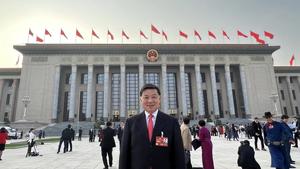 Luen Thai Group vice-chairman and CEO Henry Tan poses for a photo in front of the Great Hall of the People in Beijing, where China’s annual two sessions — the meetings of the National Committee of the Chinese People's Political Consultative Conference and the National People’s Congress — kicked off on March 4 and March 5 respectively. (PROVIDED TO CHINA DAILY)
Luen Thai Group vice-chairman and CEO Henry Tan poses for a photo in front of the Great Hall of the People in Beijing, where China’s annual two sessions — the meetings of the National Committee of the Chinese People's Political Consultative Conference and the National People’s Congress — kicked off on March 4 and March 5 respectively. (PROVIDED TO CHINA DAILY)
Hong Kong should take full advantage of the complementary strengths of the city and those of its mainland peers in the Guangdong-Hong Kong-Macao Greater Bay Area to promote its reindustrialization drive, vice-chairman and CEO of Luen Thai Group Henry Tan said.
Tan, who is also a member of the National Committee of the Chinese People's Political Consultative Conference (CPPCC), the country’s top political advisory body, made the remarks in an interview with China Daily on Monday. The country’s annual “two sessions” — the CPPCC and the National People’s Congress — kicked off on Saturday and Sunday respectively.
Hong Kong is doubling down on reindustrialization as part of its broader efforts to transform economically and develop itself into a global innovation and technology hub
“While Hong Kong has shown outstanding performance in scientific research, it still faces some deficiencies in translating research findings into marketable products. I believe Hong Kong should consider churning out products in mainland cities, intensify its commercialization efforts, and expand the global reach of its products,” the leader of Hong Kong's textile and garment industry said.
ALSO READ: Wang: CPPCC a vital united front for patriotic forces
Hong Kong is doubling down on reindustrialization as part of its broader efforts to transform economically and develop itself into a global innovation and technology hub.
In the 2022 Policy Address delivered by Chief Executive John Lee Ka-chiu in October, the Hong Kong leader made clear his aims to promote reindustrialization by improving the city’s innovation and technology ecosystem. This will involve increasing the contribution of the manufacturing sector to the city’s GDP from 1 percent in 2022 to 5 percent by 2032.
Tan proposed the creation of a textile research institute in the Greater Bay Area to facilitate cooperation among the government, the garment industry, and academic institutes.
"There is a need to increase interconnectivity between mainland cities in the Greater Bay Area and Hong Kong in research and manufacturing to enhance the commercialization of Hong Kong's scientific research achievements," he added.
Tan said Hong Kong should prioritize scientific research and marketing. “The emphasis should not be on where production occurs, but rather on identifying the city where the work can be done most efficiently to achieve optimal results," he noted.
According to Tan, relevant mainland departments should encourage more leading enterprises to establish research centers in Hong Kong.
"They can utilize Hong Kong's research outcomes, such as data, design, patents, etc., through the Greater Bay Area textile research institute. This could lead to successful commercialization and industrial upgrading, ultimately enhancing brand competitiveness," he said.
READ MORE: Xi attends opening meeting of CPPCC annual session
Tan emphasized that the most valuable part of the entire industry chain is brand development. "Hong Kong, being a superconnector between the mainland and the overseas market, could serve as a pivotal hub to drive the integration of brands and innovation and technology, enabling mainland brands to promote their products globally through Hong Kong," he said.


